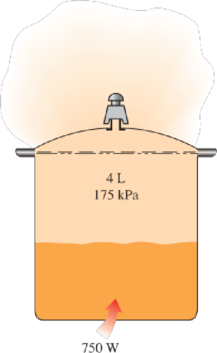
Concept explainers
A 4-L pressure cooker has an operating pressure of 175 kPa. Initially, one-half of the volume is filled with liquid water and the other half by water vapor. The cooker is now placed on top of a 750-W electrical heating unit that is kept on for 20 min. Assuming the surroundings to be at 25°C and 100 kPa, determine (a) the amount of water that remained in the cooker and (b) the exergy destruction associated with the entire process.

FIGURE P8–114
(a)
The final mass of water that remained in the cooker.
Answer to Problem 114RP
The final mass of water that remained in the cooker is
Explanation of Solution
Express the mass balance for a pressure cooker which acts as a system.
Here, initial mass is
Write an energy balance for a system.
Here, internal energy at state 1 and 2 is
Calculate the initial mass in the tank
Here, saturated liquid specific volume is
Calculate the initial internal energy
Here, specific internal energy of saturated fluid is
Calculate the initial entropy
Here, specific entropy of saturated fluid is
Write the internal energy at state 2
Here, dryness fraction at state 2 is
Write the specific volume at state 2
Write the formula to calculate the mass of the water remained in tank
Here, volume of the cooker is
Conclusion:
From the Table A-5 of “Saturated water: Pressure”, obtain the saturated liquid specific volume
From the Table A-5 of “Saturated water: Pressure”, obtain the enthalpy
Since one half of the volume is filled with liquid water and other half by water vapor, calculate the volume of tank
Substitute
Substitute 1.893 kg for
Substitute 1.893 kg for
Substitute
Substitute
Re-write the Equation (II) using the Equation (I),
Substitute
Substitute
Substitute 0.001918 for
Substitute
Thus, the final mass of water that remained in the cooker is
(b)
The amount of exergy destructed during the heating process.
Answer to Problem 114RP
The amount of exergy destructed during the heating process is
Explanation of Solution
For a closed system, write the simplification rate form of the entropy balance on an extended system which includes cooker and its immediate surroundings.
Here, entropy generation is
Calculate the exergy destroyed during the process
Here, dead state temperature is
Substitute Equation (XI) in Equation (XII).
Calculate the entropy at state 2
Conclusion:
Substitute 0.001918 for
Substitute 1.8945 kg for
Substitute 298 K for
Thus, the amount of exergy destructed during the heating process is
Want to see more full solutions like this?
Chapter 8 Solutions
CONNECT FOR THERMODYNAMICS: AN ENGINEERI
- My ID#016948724 please solve this problems and show me every step clear to follow pleasearrow_forwardMy ID# 016948724arrow_forwardPlease do not use any AI tools to solve this question. I need a fully manual, step-by-step solution with clear explanations, as if it were done by a human tutor. No AI-generated responses, please.arrow_forward
- Please do not use any AI tools to solve this question. I need a fully manual, step-by-step solution with clear explanations, as if it were done by a human tutor. No AI-generated responses, please.arrow_forwardPlease do not use any AI tools to solve this question. I need a fully manual, step-by-step solution with clear explanations, as if it were done by a human tutor. No AI-generated responses, please.arrow_forward[Q2]: The cost information supplied by the cost accountant is as follows:Sales 20,00 units, $ 10 per unitCalculate the (a/ newsale guantity and (b) new selling price to earn the sameVariable cost $ 6 per unit, Fixed Cost $ 30,000, Profit $ 50,000profit ifi) Variable cost increases by $ 2 per unitil) Fixed cost increase by $ 10,000Ili) Variable cost increase by $ 1 per unit and fixed cost reduces by $ 10,000arrow_forward
- can you please help me perform Visual Inspection and Fractography of the attatched image: Preliminary examination to identify the fracture origin, suspected fatigue striation, and corrosion evidences.arrow_forwardcan you please help[ me conduct Causal Analysis (FTA) on the scenario attatched: FTA diagram which is a fault tree analysis diagram will be used to gain an overview of the entire path of failure from root cause to the top event (i.e., the swing’s detachment) and to identify interactions between misuse, material decay and inspection errors.arrow_forwardhi can you please help me in finding the stress intensity factor using a k-calcluator for the scenario attathced in the images.arrow_forward
 Elements Of ElectromagneticsMechanical EngineeringISBN:9780190698614Author:Sadiku, Matthew N. O.Publisher:Oxford University Press
Elements Of ElectromagneticsMechanical EngineeringISBN:9780190698614Author:Sadiku, Matthew N. O.Publisher:Oxford University Press Mechanics of Materials (10th Edition)Mechanical EngineeringISBN:9780134319650Author:Russell C. HibbelerPublisher:PEARSON
Mechanics of Materials (10th Edition)Mechanical EngineeringISBN:9780134319650Author:Russell C. HibbelerPublisher:PEARSON Thermodynamics: An Engineering ApproachMechanical EngineeringISBN:9781259822674Author:Yunus A. Cengel Dr., Michael A. BolesPublisher:McGraw-Hill Education
Thermodynamics: An Engineering ApproachMechanical EngineeringISBN:9781259822674Author:Yunus A. Cengel Dr., Michael A. BolesPublisher:McGraw-Hill Education Control Systems EngineeringMechanical EngineeringISBN:9781118170519Author:Norman S. NisePublisher:WILEY
Control Systems EngineeringMechanical EngineeringISBN:9781118170519Author:Norman S. NisePublisher:WILEY Mechanics of Materials (MindTap Course List)Mechanical EngineeringISBN:9781337093347Author:Barry J. Goodno, James M. GerePublisher:Cengage Learning
Mechanics of Materials (MindTap Course List)Mechanical EngineeringISBN:9781337093347Author:Barry J. Goodno, James M. GerePublisher:Cengage Learning Engineering Mechanics: StaticsMechanical EngineeringISBN:9781118807330Author:James L. Meriam, L. G. Kraige, J. N. BoltonPublisher:WILEY
Engineering Mechanics: StaticsMechanical EngineeringISBN:9781118807330Author:James L. Meriam, L. G. Kraige, J. N. BoltonPublisher:WILEY





